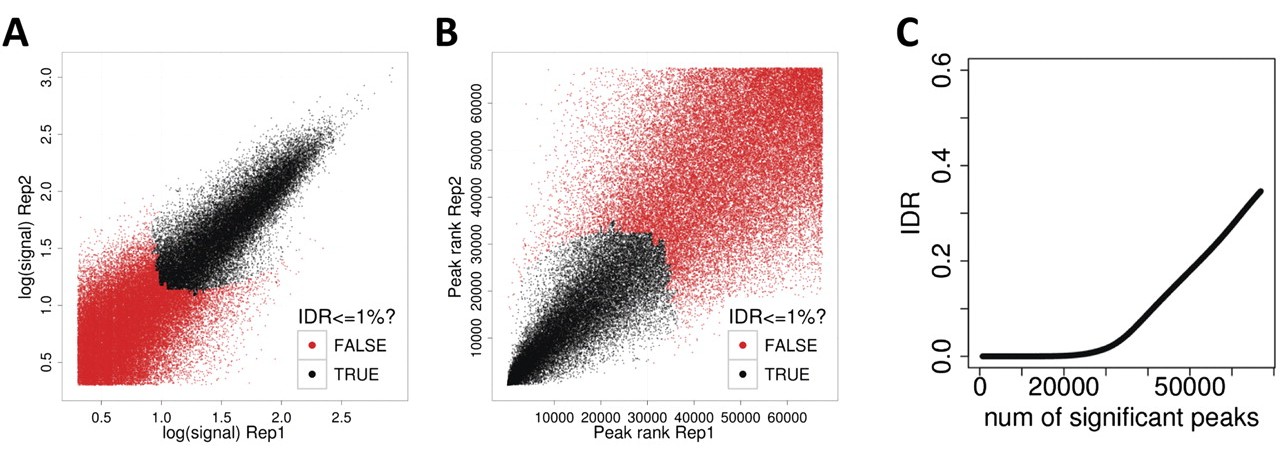Navigate into the directory containing data and launch R. Load the following file:
source("functions-all-clayton-12-13.R")
Read peak files and genome table:
peakfile1 <- "HUVEC_hg19_CTCF_rep1.bed"
peakfile2 <- "HUVEC_hg19_CTCF_rep2.bed"
chr.size <- read.table("genome_table.txt")
Define parameters:
half.width <- NULL
overlap.ratio <- 0
is.broadpeak <- F
sig.value <- "p.value"
- [half.width]: Set this to -1 (NULL) if you want to use the reported peak width in the peak files.
- [overlap.ratio]: fractional bp overlap (ranges from 0 to 1) between peaks in replicates to be considered as overlapping peaks. IMPORTANT: This parameter has not been tested fully. It is recommended to set this to 0.
- [is.broadpeak]: Is the peak file format narrowPeak or broadPeak. Set to F if it is narrowPeak/regionPeak or T if it is broadPeak.
- [ranking.measure] is the ranking measure to use. It can take only one of the following values
signal.value, p.value or q.value.
Process data and generate IDR output.
rep1 <- process.narrowpeak(paste(peakfile1, sep=""), chr.size,
half.width=half.width, summit="offset", broadpeak=is.broadpeak)
rep2 <- process.narrowpeak(paste(peakfile2, sep=""), chr.size,
half.width=half.width, summit="offset", broadpeak=is.broadpeak)
uri.output <- compute.pair.uri(rep1$data.cleaned, rep2$data.cleaned,
sig.value1=sig.value, sig.value2=sig.value, overlap.ratio=overlap.ratio)
em.output <- fit.em(uri.output$data12.enrich, fix.rho2=T)
idr.local <- 1-em.output$em.fit$e.z
IDR <- c()
o <- order(idr.local)
IDR[o] <- cumsum(idr.local[o])/c(1:length(o))
idr_output <- data.frame(chr1=em.output$data.pruned$sample1[, "chr"],
start1=em.output$data.pruned$sample1[, "start.ori"],
stop1=em.output$data.pruned$sample1[, "stop.ori"],
sig.value1=em.output$data.pruned$sample1[, "sig.value"],
chr2=em.output$data.pruned$sample2[, "chr"],
start2=em.output$data.pruned$sample2[, "start.ori"],
stop2=em.output$data.pruned$sample2[, "stop.ori"],
sig.value2=em.output$data.pruned$sample2[, "sig.value"],
idr.local=1-em.output$em.fit$e.z, IDR=IDR)
write.table(idr_output, "idr_overlapped_peaks.txt", sep="", quote=F)
Getting peaks that pass the IDR threshold:
filtered_peaks <- idr_output[idr_output[,10]<=0.01,]
dim(filtered_peaks) # get the number of peaks
